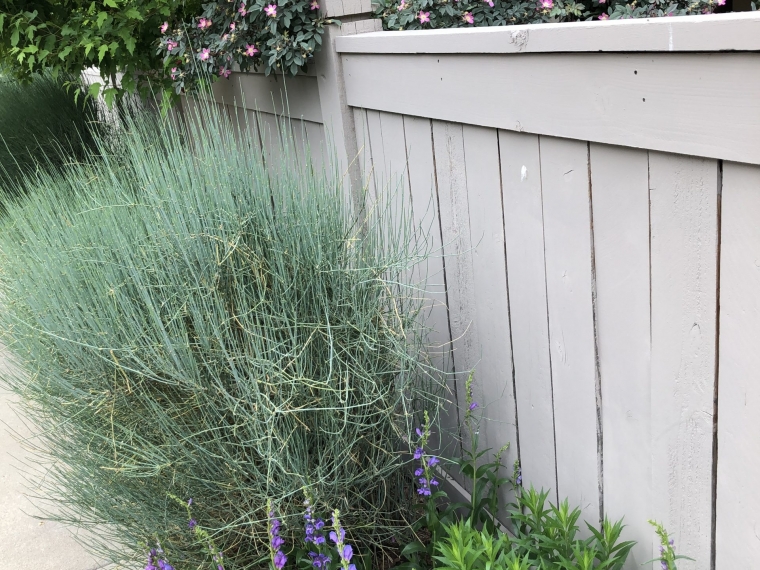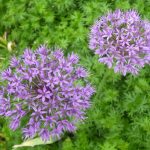
Purple Sensation Allium
Bulb. Z3. 24-36” tall. Blooms late spring to early summer. Compost-improved soil.
Really a garden standout. It’s the statuesque spring blooming bulb that your neighbors always admire and ask about. 4-5” spherical flowerheads are deep purple and attractive to pollinators including bees, butterflies and hummingbirds. Deer and rabbit resistant. Gorgeous in flower arrangements cut fresh or dried. Easily naturalizes throughout your garden. Wonderful planted with Moonshine yarrow, artemisias with grey foliage, and orange-flowering geums like ‘Mrs. Bradshaw’.



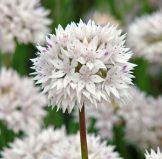 Circa 1857, this delicate-looking yet easy-growing North American native has composite 3″ globes of star-shaped, sparkling white flowers with pale lavender stamens tipped with purple anthers and sturdy stems.
Circa 1857, this delicate-looking yet easy-growing North American native has composite 3″ globes of star-shaped, sparkling white flowers with pale lavender stamens tipped with purple anthers and sturdy stems. Formulated and made in Boulder by ‘the doctor’ himself (our founder, Mikl Brawner), from 99% pure Aloe Vera Gel, with cold-pressed, organic Rosehip Seed Oil; 100% pure Jojoba Oil, and 32,000 IU Vitamin E Oil, along with essential oils of Lavender, Vetiver, and Rose. That’s all. No alcohol, nothing synthetic, non-greasy. All the ingredients are natural plant products, chosen for their skin-healing qualities. The steam-distilled Rose Oil is a powerful anti-viral and antiseptic. The other ingredients are good for healing burns and dry and damaged skin, inflammation, wrinkles. They are moisturizing and uplifting to the spirits.
Formulated and made in Boulder by ‘the doctor’ himself (our founder, Mikl Brawner), from 99% pure Aloe Vera Gel, with cold-pressed, organic Rosehip Seed Oil; 100% pure Jojoba Oil, and 32,000 IU Vitamin E Oil, along with essential oils of Lavender, Vetiver, and Rose. That’s all. No alcohol, nothing synthetic, non-greasy. All the ingredients are natural plant products, chosen for their skin-healing qualities. The steam-distilled Rose Oil is a powerful anti-viral and antiseptic. The other ingredients are good for healing burns and dry and damaged skin, inflammation, wrinkles. They are moisturizing and uplifting to the spirits.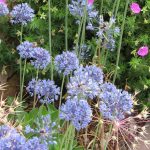 Allium caeruleum (syn. A. azureum) (Blue Globe Onion)
Allium caeruleum (syn. A. azureum) (Blue Globe Onion)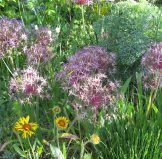 A most surprising, outrageous flower for xeriscapes! The giant globes, to 10” diameter or more, are held on fairly short stems, 8”-18” tall, blooming in mid-spring. The hundreds of starry, silver-lavender florets each have a green ‘eye’ are arranged so that their petal-tips touch to form a perfect sphere. This easy naturalizer has been highly successful in our xeriscape display gardens, eliciting lots of interest. Also spectacular in large flower arrangements, fresh or dried.
A most surprising, outrageous flower for xeriscapes! The giant globes, to 10” diameter or more, are held on fairly short stems, 8”-18” tall, blooming in mid-spring. The hundreds of starry, silver-lavender florets each have a green ‘eye’ are arranged so that their petal-tips touch to form a perfect sphere. This easy naturalizer has been highly successful in our xeriscape display gardens, eliciting lots of interest. Also spectacular in large flower arrangements, fresh or dried.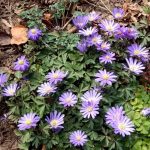 An enchanting, early-blooming member of the Buttercup family that grows from a tuber. Where happy, it spreads to form a carpet-like groundcover with ferny deep green foliage and 1”- wide open-faced sky-blue daisy flowers with yellow eyes. Provides a long-lasting display in early spring.
An enchanting, early-blooming member of the Buttercup family that grows from a tuber. Where happy, it spreads to form a carpet-like groundcover with ferny deep green foliage and 1”- wide open-faced sky-blue daisy flowers with yellow eyes. Provides a long-lasting display in early spring.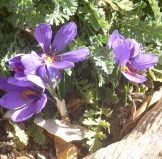 This fall-blooming crocus emerges as a cheery surprise in October or November with bright violet-purple open cupped petals and brilliant orange stigmas, the source of the precious spice, saffron. The blooms are accompanied by short blades of dark green, grass-like foliage which elongates after the flowers have finished and may re-appear in spring.
This fall-blooming crocus emerges as a cheery surprise in October or November with bright violet-purple open cupped petals and brilliant orange stigmas, the source of the precious spice, saffron. The blooms are accompanied by short blades of dark green, grass-like foliage which elongates after the flowers have finished and may re-appear in spring.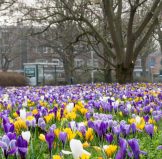 Crocus Specie Mixed
Crocus Specie Mixed
 Native to rocky hillsides from SW and Central Asia (Syria to Afghanistan), this lovely wildflower in the Amaryllis family bears umbels of starry violet-blue flowers with darker midveins above grass-like foliage for 3 to 4 weeks in late May and early June.
Native to rocky hillsides from SW and Central Asia (Syria to Afghanistan), this lovely wildflower in the Amaryllis family bears umbels of starry violet-blue flowers with darker midveins above grass-like foliage for 3 to 4 weeks in late May and early June.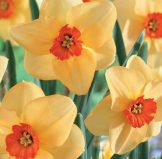 While ‘Altruist’ Narcissus has the classic daffodil look, the colors are anything but ordinary! This striking award-winner has a 3″ coppery golden-orange perianth that pales as it matures, the perfect background for the shallow, bowl-shaped crimson-orange cup. Altruist is long-lived and floriferous, and its unusual and gorgeous coloring make it a stand-out in the garden and as a cut flower. Pest-proof!
While ‘Altruist’ Narcissus has the classic daffodil look, the colors are anything but ordinary! This striking award-winner has a 3″ coppery golden-orange perianth that pales as it matures, the perfect background for the shallow, bowl-shaped crimson-orange cup. Altruist is long-lived and floriferous, and its unusual and gorgeous coloring make it a stand-out in the garden and as a cut flower. Pest-proof!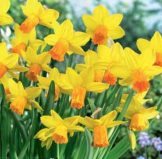 An old favorite for naturalizing, and another Cyclamineus daffodil. Bright and cheerful in the garden, with reflexed vivid yellow petals and orange-red trumpet. ‘Jetfire’ is early blooming, and increases rapidly to form showy colonies. Very long-blooming, tough and adaptable. Also good for forcing indoors.
An old favorite for naturalizing, and another Cyclamineus daffodil. Bright and cheerful in the garden, with reflexed vivid yellow petals and orange-red trumpet. ‘Jetfire’ is early blooming, and increases rapidly to form showy colonies. Very long-blooming, tough and adaptable. Also good for forcing indoors.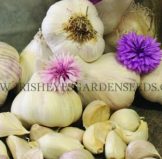
 Harlequin’s blend of certified organic fertilizer, humate, rock minerals, dry molasses, land: sourced coral calcium and mycorrhizae. Great for veggie gardens and all plants. Increases root mass, top growth, soil life, and productivity naturally. This is not just a fertilizer. The combination of ingredients and mycorrhizae act synergistically to support fertility.
Harlequin’s blend of certified organic fertilizer, humate, rock minerals, dry molasses, land: sourced coral calcium and mycorrhizae. Great for veggie gardens and all plants. Increases root mass, top growth, soil life, and productivity naturally. This is not just a fertilizer. The combination of ingredients and mycorrhizae act synergistically to support fertility. We are making compost tea with a biodynamic compost, a mineral concentrate, kelp extract, molasses, etc., and it is being made in a Vortex brewer. Compost tea increases the soil life (beneficial micro-organisms), which can bring more nutrients and water to the plants and make them stronger and better able to cope with stress. It can be used full-strength as a mild organic fertilizer, or it can be diluted in water up to 3 times as a soil inoculant. It can also be used to inoculate compost piles to make materials break down faster. We have observed some very good results and received positive reports from customers who have tried it. Bring your own jugs, or use ours for a $1 deposit (refundable upon return).
We are making compost tea with a biodynamic compost, a mineral concentrate, kelp extract, molasses, etc., and it is being made in a Vortex brewer. Compost tea increases the soil life (beneficial micro-organisms), which can bring more nutrients and water to the plants and make them stronger and better able to cope with stress. It can be used full-strength as a mild organic fertilizer, or it can be diluted in water up to 3 times as a soil inoculant. It can also be used to inoculate compost piles to make materials break down faster. We have observed some very good results and received positive reports from customers who have tried it. Bring your own jugs, or use ours for a $1 deposit (refundable upon return).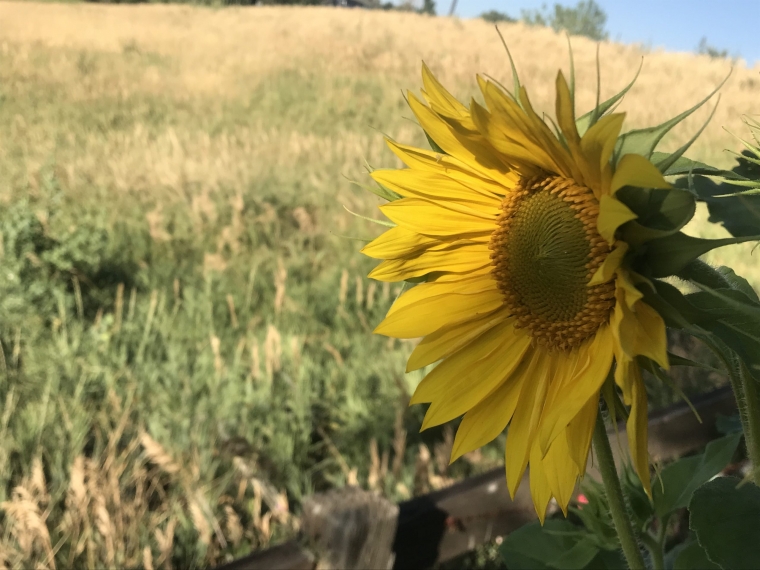

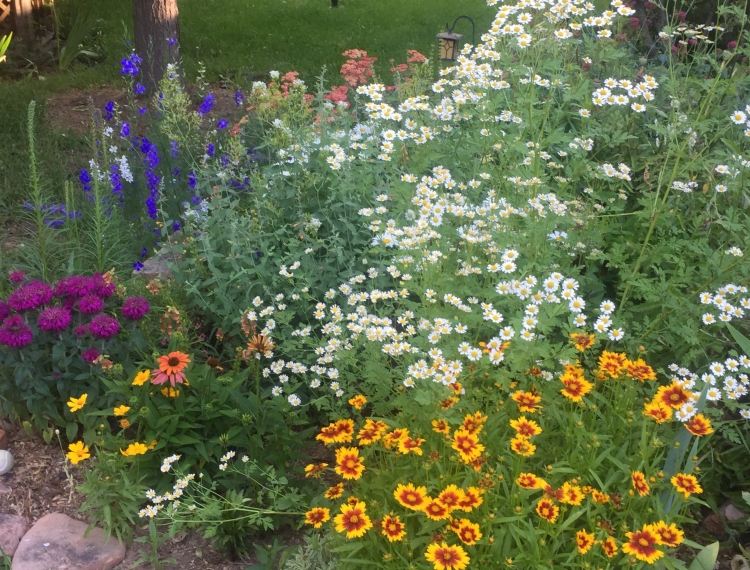
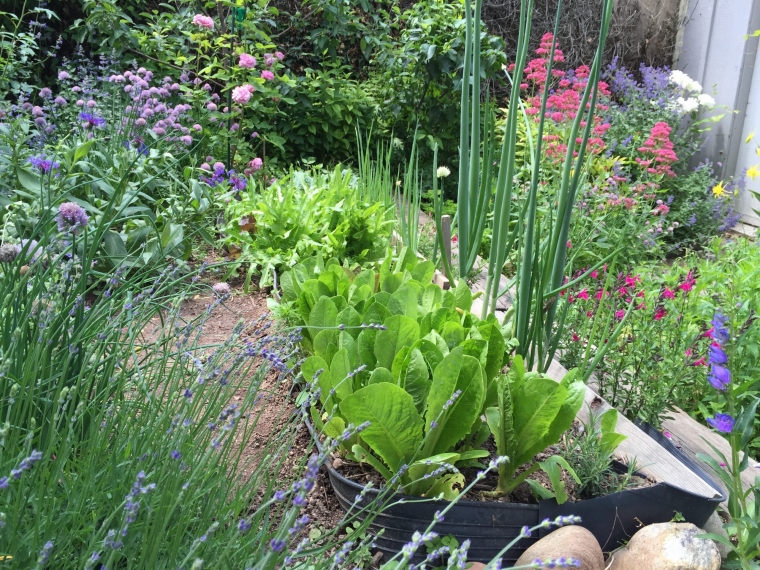
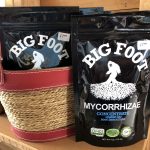 The Soil Food Web is an important component for healthy plants. This concentrate has not only outstanding Mycorrhizae but also carriers of Biochar, kelp and worm castings. Improve water and nutrienet uptake, root growth and plant growth while reducing transplant shock and drought stress.
The Soil Food Web is an important component for healthy plants. This concentrate has not only outstanding Mycorrhizae but also carriers of Biochar, kelp and worm castings. Improve water and nutrienet uptake, root growth and plant growth while reducing transplant shock and drought stress.